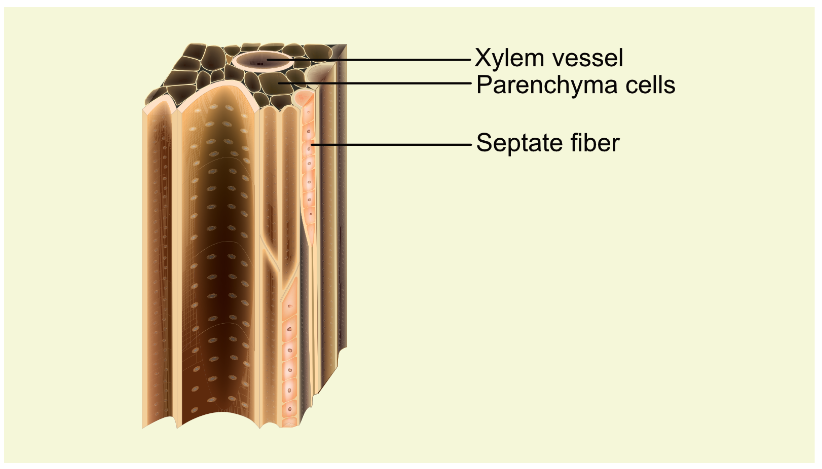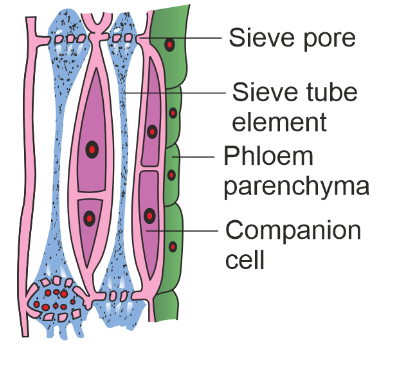Table of Contents
Difference Between Xylem and Phloem
At the heart of this botanical symphony are the vascular tissues, xylem and phloem, each with its unique structure, components, and crucial functions. In this article, we unravel the distinctions between xylem and phloem, shedding light on their roles in plant physiology.
Structure and Components of Xylem
Structure: Xylem, responsible for water and mineral transport, boasts a robust structure. It’s composed of various cell types that collaboratively facilitate efficient water movement from roots to the rest of the plant. The main cell types in xylem are tracheids, vessel elements, fibers, and parenchyma cells.
Components
Tracheids: Elongated cells with tapered ends and secondary cell walls thickened by lignin, aiding in water transport.
Vessel Elements: Short, cylindrical cells aligned end-to-end to form vessels. Perforation plates in their end walls enhance water flow.
Fibers: Cells providing mechanical support through thick cell walls made of cellulose and lignin.
Parenchyma Cells: Living cells also known as ray cells, involved in storage and horizontal movement of water and nutrients.

Function of Xylem
Xylem’s primary function is to transport water and minerals from the roots, where they are absorbed, to the other parts of the plant. This upward movement, against gravity, is driven by transpiration – the loss of water vapor from leaves, creating a negative pressure that draws water through the xylem.
Structure and Components of Phloem
Structure: Phloem, the nutrient distribution system, is composed of specialized cells that form a pipeline for the transport of sugars, amino acids, and other organic compounds.
Components
Sieve Tubes: Elongated cells with perforated end walls called sieve plates, allowing the flow of sap containing nutrients.
Companion Cells: Living cells adjacent to sieve tubes, supporting their metabolic functions and assisting in loading and unloading of nutrients.
Fibers: Similar to xylem fibers, providing mechanical support.
Phloem parenchyma: The phloem parenchyma consists of elongated, tapering cylindrical cells characterized by their dense cytoplasm and prominent nucleus. Within the phloem parenchyma, there is a storage of various substances, including food materials, resins, latex, and mucilage. Notably, in most monocotyledonous plants, phloem parenchyma is not present.

Function of Phloem
Phloem plays a pivotal role in the transport of sugars produced in photosynthetic tissues (usually leaves) to other parts of the plant for growth, storage, or energy. This movement is known as translocation and occurs through mechanisms involving active transport and osmotic pressure.
Difference Between Xylem and Phloem:
| Characteristic | Xylem | Phloem |
| Function | Water and mineral transport | Nutrient (sugar) transport |
| Composition | Tracheids, vessel elements, fibers, parenchyma cells | Sieve tubes, companion cells, fibers |
| Cell status | Dead at maturity | Alive at maturity |
| Transport Mechanism | Passive transport (cohesion-tension) | Active transport (pressure flow hypothesis) |
| Direction of flow | Unidirectional | Bidirectional |
Frequently Asked Questions (FAQs) on Difference Between Xylem and Phloem
What is the primary role of xylem and phloem?
Xylem and phloem are the two main components of a plant's vascular system. The primary role of xylem is to transport water and minerals from the roots to other parts of the plant, while the phloem's main function is to distribute nutrients, such as sugars and organic compounds, produced in photosynthetic tissues to various parts of the plant.
How does water move through the xylem?
Water flow through the xylem is unidirectional. Transpiration is the loss of water vapor from the leaves through tiny openings called stomata. As water evaporates from the leaves, it creates a negative pressure that pulls water upward from the roots through the xylem vessels and tracheids, creating a continuous flow.
What are sieve tubes and companion cells in the phloem?
Sieve tubes are specialized cells in the phloem responsible for transporting sugars and nutrients. They have perforated end walls known as sieve plates, which allow the movement of sap from cell to cell. Companion cells, on the other hand, are living cells closely associated with sieve tubes. They provide metabolic support to the sieve tubes, helping them maintain their functions, and are involved in loading and unloading nutrients.
What is the primary function of the phloem in a plant?
The primary function of the phloem in a plant is to transport organic nutrients, primarily sugars produced through photosynthesis, from the site of their production (usually the leaves) to other parts of the plant where they are needed for growth, energy, and storage.








